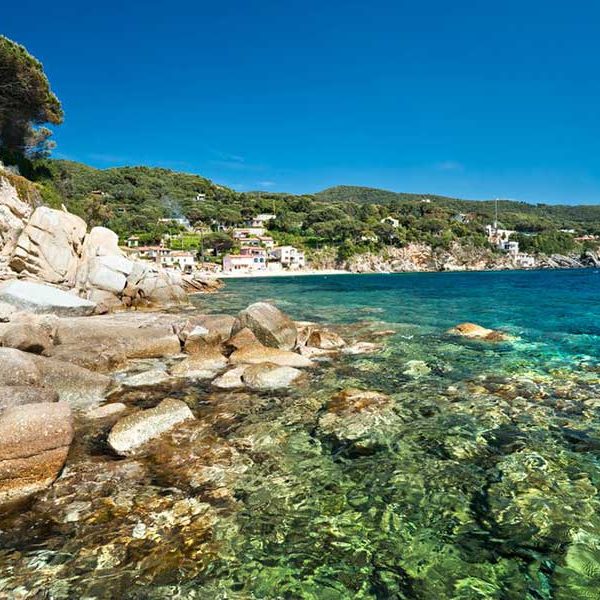ITALY – Tuscan Archipelago
The green Capraia with its coloured coast, with its small port and with the unmistakable scent of lentisk is always the same during the years. Even in August , when the port is completely full, the tourism is not nosy: here you breathe pure sea air. Every day the boats travel through the small port a big population of sailors, skin divers and simple bathers who want to spend their holidays in bathing customs. The vegetation is flourishing and full of Mediterranean species. It fought against the volcanic nature but at the end it got the better as you can see from the lively and vegetable cover. The landscapes created by the vegetation with the help of the wind are really spectacular: thousand of daises, asphodels, the expanse of sea cistus with white flowering, the perfumed expands of “elicriso” and the plans with heather, strawberry-trees, myrtle and oleanders.
Elba Island lies 10 km only from the mainland and is the largest island in the Tuscan Archipelago; having a surface area of 224 sq. km, it is the third Italian island in size. Elba has become an internationally famous tourist resort. Her climate is particularly mild. Her coastline, which winds for 147 km., is incredibly varied. The grandeur of the Mount Capanne group (1019 mt.) is magnificent. A “man size” island, Elba has been able to snatch up all the benefits from modern civilisation, its comforts and technology, without however compromising her nature, landscape, sea and coast, mountains and woods. She hasn’t allowed her ancient villages to be disfigured nor the remains of her ancient civilisation to be destroyed. Elba is like a treasure chest rich in delightful surprises, framed by crystal-clear waters which caress sandy beaches, secret green bays and inlets, or steep cliffs. Inland environments range from shady woods, to sweet cultivated fields, to barren lands where aloe and cactus reign. And then you have Elba’s towns: those on the sea, which often maintain the ancient flavour of a fishermen’s shelter, and those chiselled out of the rock up high, which still tell us about pirate raids of long ago
Giannutri Island stands aside compared to the other islands of the Tuscan archipelago but thanks to its geographical distance it is a very special place, perhaps unique and inimitable. Giannutri is a very small paradise , it is 500m .large and more or less 5 kms long, a beautiful walk. It is the ideal place for excursions and is attended especially by ski divers charmed by its depths. In the past Giannutri had already charmed the Romans who built a port and beautiful patrician villas. The sea is still keeping wrecks of their ships. The depths contain falaises, caves, meadows of Poseidonia, sea fans, sea roses, sea horses, sea stars, corals, sea urchins, dentexes, sargas, sponges but also wrecks. It is possible to meet dolphins, a whale or a turtle too. Giannutri is a real natural place with no beaches but only inaccessible rocks to barefoot. From the main rise the Poggio Capel Rosso, a 85m. peak, you can watch only the sea and no land can be perceived even in the clear days. The silence is broken by the thousand noises of the nature which is here the only actor .
Gorgona Island is the smaller of the Tuscan Archipelago to the west of Leghorn, it has got 300 inhabitants ( for the most part convicts) and is little more than 2 squared kms wide, it is mostly occupied by the goal . It has got a rocky ground, reaches the 225metres of altitude and is covered by the Mediterranean bush. The visit to the island, where the tourist can moor only in case of danger, is allowed each Tuesday of the summer’s months to small groups which are taken by a patrol boat from a ferry on service between Leghorn, Capraia and Elba. The tour is organised by the natural park ‘s cooperative society and includes the most suggestive places of the coasts, among them Cala Scirocco and Cala Martina and the areas covered by the Mediterranean bush which is a shelter for the wild rabbits, gulls, birds of passage and sea swallows. What catches one’s eye is the vegetation: the about 90% of the island in fact has got a Mediterranean bush which gives hospitality to more than 400 flora species.
Giglio Island is in the centre of the Tyrrhenian sea, 11 miles far from the Promontorio dell’Argentario, and keeps inside its 21,21 square kilometres a treasure to be discovered . Its mild climate makes the island the ideal place for all season’s holidays. An uncontaminated reality . The crystal emerald sea with its rich in fishes depths is the frame of an area which is for the 90% still wild and which invites the visitors to go on excursions. Giglio’s port is a picturesque docking surrounded by high grounds full of vineyards. In the nearby of the docking of the ferries there are always expert boatmen ready to carry tourists in the near beaches. The bushes of poseidonia seem to emerge from the transparent water and the fishes looking for some food seem touchable as if they were within reach.
Pianosa Island has been protected from the prison for 142 years, first penal settlement, and high security prison up today. The island is flat but also a unique resource: meadows of Poseidonia, a real “nursery” of the ichthyic fauna of the high Tyrrhenian sea , the most important catacombs to the north of Rome, the roman villa of Agrippa, the sanatorium of Punta Marchese where also Sandro Pertini was banished, a rich fauna and flora with many rarities due also to the isolated evolution and to an extraordinary migratory flow. The prison moreover, with its potentials, is a modern monument of the history of our land which goes from the robbers of the Maremma to the Austrian prisoners and includes the years of the terrorism and the slaughters of the Mafia. The wall which splits the island was built in the 1978 and it is a historic proof too. Unfortunately in the closed area there are the bays and the most beautiful cliffs of the all Tuscan archipelago. Pianosa is the only Tuscan island composed of sedimentary rocks. Thanks to its calcareous nature and to its level ground it has been cultivated since the ancient times.
Montecristo Island is wild and uninhabited, covered with Mediterranean bush and important shelter for birds of passage. It’s about 10 square Km wide and is one of the most wild island of the entire Tuscan Archipelago and the most far from the coast . Montecristo Island is composed of grey-pink granite , has got a wide, low pyramid shape and is rich in vegetation. Its inhospitable aspect kept the people away from the island during the centuries until in the V century when monks and hermits started doing a part of the territory hospitable. When you get ashore at Cala Maestra it is possible to see the only building of the island Villa Watson-Taylor where there are the sole trees of the all island. As for the fauna the wild goats are the rulers of the area , there are in fact about 400-500 animals probably coming from Minor Asia and carried there perhaps by the Phoenicians but now they are wild again. Their voracity has changed gradually the original Mediterranean bush.
The best period for cruising this area goes from April to October.


